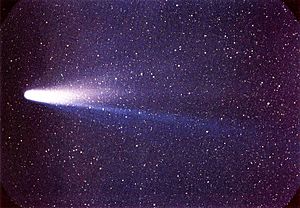Periodic comet facts for kids
A periodic comet is a comet which orbits around the Sun. A short-period comet will complete its orbit in less than 200 years. A long-period comet will take more than 200 years to orbit. In most cases the comets are named after the person who discovered them. The Shoemaker-Levy comets were named after Eugene Shoemaker, Carolyn Shoemaker and David Levy. A few comets are named after the person who calculated the orbits, such as 2P/Encke and 27P/Crommelin. It is very difficult to work out the orbit of a long-period comet because of the effect of planets, or the release of gas or material from the comet itself. Short-period comets can be predicted with a lot of accuracy.
Periodic comets sometimes have the same name, for example there are nine Shoemaker-Levy comets and twenty-four NEAT comets. The Minor Planet Center, a part of the International Astronomical Union gives comets a different number prefix or uses the full title such as 181P/Shoemaker-Levy and 192/Shoemaker-Levy which are both "Comet Shoemaker-Levy". Sometimes an informal numbering system is used for periodic comets so 181P is Comet Shoemaker-Levy 6 and 192P is Comet Shoemaker-Levy 1. Because non-periodic Shoemaker-Levy comets are included in the number sequences there appear to be gaps in the numbers, for example C/1991 B1 is between Shoemaker-Levy 2 and 3, C/1991 T2 is between 5 and 6, C/1993 K1 and C/1994 E2 after Shoemaker-Levy 9.
In naming a comet, the letter before the "/" is:
- "C" for a non-periodic comet
- "P" is a periodic comet
- "D" is a comet which has been lost or has disintegrated
- "X" is a comet for which no reliable orbit could be calculated –usually historical comets
- "A" for an object that was thought to be comet, but is actually a minor planet.
Some lists keep the "C" prefix for comets of with orbits longer than about 30 years until their return is confirmed.
Related pages
See also
 In Spanish: Anexo:Cometas periódicos para niños
In Spanish: Anexo:Cometas periódicos para niños


